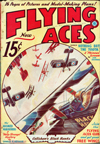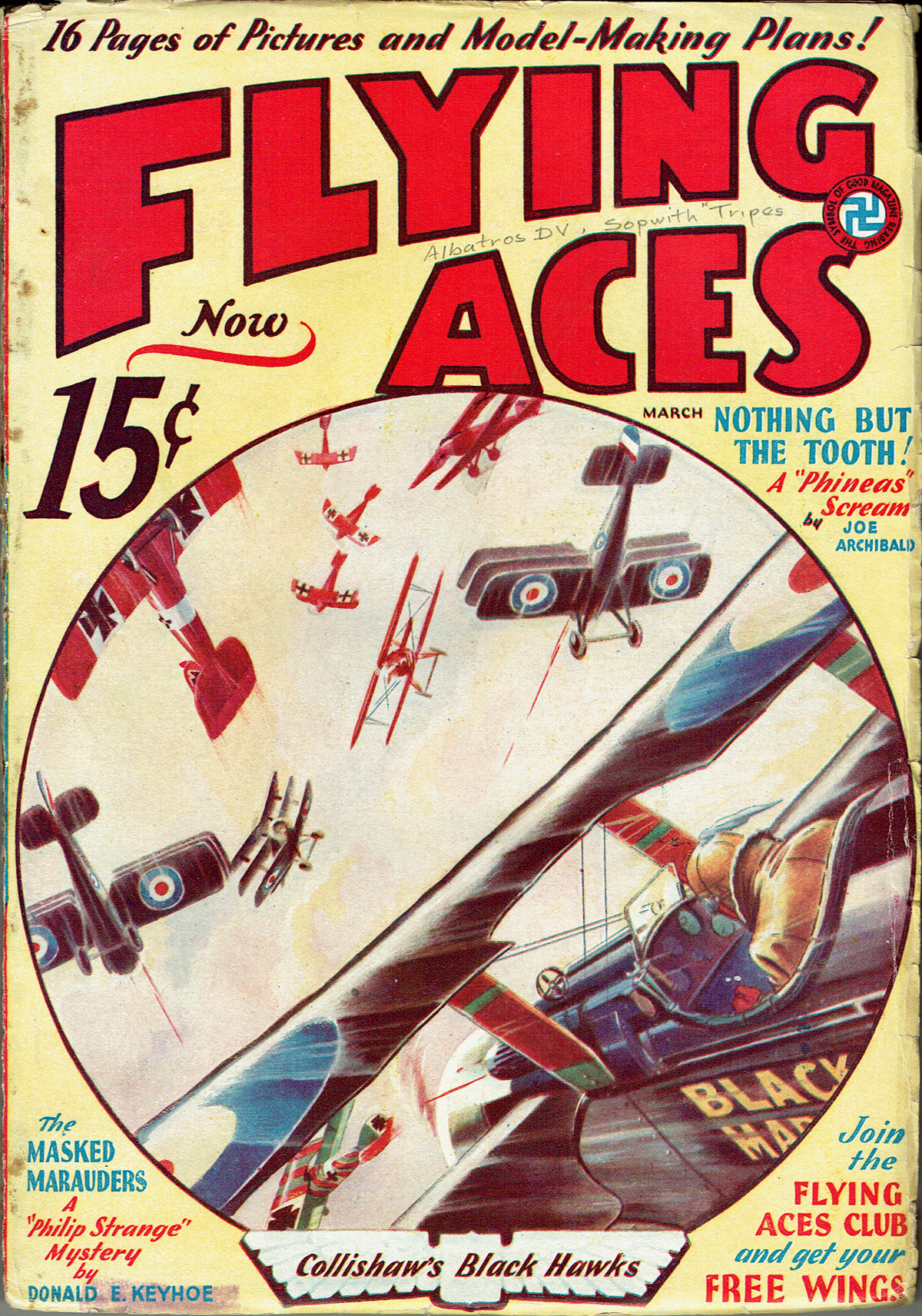THIS week we present “Downing the L-22″—The story behind the cover of Paul Bissell’s June 1933 cover for Flying Aces! Bissell is mainly known for doing the covers of Flying Aces from 1931 through 1934 when C.B. Mayshark took over duties. For the June 1933 cover Bissell put us right in the action As Galpin and Leckie’s Phoenix Cork flying boat is caught in the searchlights of the mighty L-22 Zeppelin!
Downing the L-22
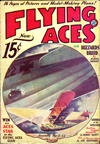 FROM the very outbreak of the World War it was apparent to the British that with an aggressive foe only a comparatively few miles across the water from them, England would be subjected to constant and continued air raids. With this in mind the Air Ministry attempted to build up an adequate defense, but with aviation in its infancy, and no past experience to help them, this task proved much more difficult than was at first apparent. The inadequacy of the defense first built up was quickly evident when the Germans began seriously to raid England in the early summer of 1915.
FROM the very outbreak of the World War it was apparent to the British that with an aggressive foe only a comparatively few miles across the water from them, England would be subjected to constant and continued air raids. With this in mind the Air Ministry attempted to build up an adequate defense, but with aviation in its infancy, and no past experience to help them, this task proved much more difficult than was at first apparent. The inadequacy of the defense first built up was quickly evident when the Germans began seriously to raid England in the early summer of 1915.
Almost every dark night one or more of the huge Zeppelins would slip through the blackness, drop its bombs, and disappear again—untouched. To be sure, the alarm would have been given, and plane after plane would be up searching for the enemy, while the night would be pierced by hundreds of bright beams trying vainly to find the giant ships. Often the huge shapes of the Zeps, silhouetted against the lighted sky above, would be clearly visible to those on the ground, but quite invisible to those high in the air, groping vainly for them.
And even if spotted, the Zep was by no means an easy prey. It had a flying speed almost equal to most of the planes of that time, while its ceiling was higher than could be obtained by the majority of them. And, even if caught at lower altitudes, merely by dropping its water ballast it could rise with a rapidity that made pursuit almost hopeless.
It was well-armed, too. Machine guns were mounted in each gondola, and in the main cabin, while on top; of the envelope at either end was a gun platform.
To be sure, not every raid was carried out successfully, or without serious losses. The difficulties offered to the defenders of the British coast only served to increase the determination of the British pilots, and more than one story of dare-devil bravery and achievement crowned with victory was written in flames against the night skies above England, as some huge Zeppelin hurtled down through space to destruction, the victim of one of Britain’s air heroes—Robinson, Warneford, Tempest, Brandon, Cadbury — just to mention a few of them.
There was probably not a pilot who, no matter what his individual mission might be, did not hope that some time, slipping out of a blinding fog bank, he might find himself face to face with a Zeppelin. They perhaps said little about it, and daily carried out whatever job was assigned to them. But they quietly longed and waited for that day when fate would be kind and give them their big chance.
AND so it was with the crew of the Phoenix Cork flying boat, H12-8666, of the Great Yarmouth station. They had gone out to drop a few eggs on the enemy hangars over in Belgium, but on the way high adventure overtook them.
With Flight Lieutenant Galpin as navigator, and Sub-Lieutenant Leckie as pilot, they left Great Yarmouth station at three o’clock on the morning of May 14, 1917. Four one-hundred-pound bombs were strapped beneath their wings, and they carried three Lewis machine guns—a double one mounted in the forward cockpit, and one aft in the side door.
They had proceeded about eighty miles toward their objective and gained about six thousand feet of altitude when they plunged suddenly into a dense fog bank. Until now the. trip had been uneventful, just a careful watch out as they sped along, searching the scarcely visible horizon for the first suggestion of daylight. Now, however, there was no horizon, no top, no bottom—above, below, to either side—just a dark mass of nothingness through which they winged their way, guiding themselves only by their instruments.
Lieutenant Leckie kept the plane climbing gradually until he had finally reached an elevation of ten thousand feet, and figured that he must be nearing the Belgian coast. He cursed the thick fog that made him as helpless as a blind man. The blackness around had faded to a dirty gray, heralding the approach of day. Then suddenly, like slipping from a dark room, they shot out into the clear air. Off in the east, dawn pushed its long fingers up into the heavens. Below were the waters of the channel, still black as seen between other fog banks and huge cloud formations which extended interminably, billow on billow, off into the distance.
But straight ahead, and some six thousand feet below them, was a shape that sent the hearts of the Britishers into their throats. Scarcely visible in the early light, but with each second making their hope more and more certain, was the silvery shape of a German Zeppelin.
Instantly all thought of their objective was forgotten. Their big chance was here. Without need of a command, the pilot altered his course, and headed directly for the big ship. Galpin manned the forward twin gun, while Whatling, the wireless operator, manned the aft gun. With throttle wide open and nosing over slightly to gain speed, the flying boat tore ahead. Had the Zep seen them? Would she turn and run for it? Or would she ascend rapidly and wireless for help? Quickly they crept up. Only a mile separated them—then only half a mile.
On the side of the Zep the numerals L-22 and the Black Cross now stood out boldly. Then the Zep seemed suddenly to come to life. She changed her direction, at the same time dropping volumes of water as she discharged her ballast, and her nose shot violently upward. But Leckie had anticipated just this maneuver, and though he had sacrificed some of his altitude, he was still some five hundred feet above the Zep. Without hesitation Galpin dropped three of his four bombs. Every pound counted. Now they must have every bit of speed that was possible.
Already the Germans from the top platform were raking them with machine-gun fire. Then Leckie turned her over in one last headlong dive, pulling her up just under the rear fin and not forty yards from the back gondola. Immediately they were met by a terrific fire from the two gondolas. Bullets whizzed by, tearing pieces of fabric from their wings.
But now Galpin’s guns were also in action. Burst after burst of incendiary bullets he saw bury themselves in the rear end of the big envelope. Leckie piloted the machine skilfully, swinging from one side to another under the big dirigible, offering as difficult a target as possible and at the same time tipping up on one wing so as to give Whatling a chance to bring the rear gun into action.
The Zep was climbing rapidly, and Leckie strove desperately to hold his position in spite of the backwash from the German’s five propellers. Another burst of fire from Galpin, and then his guns jammed. Now they were in a perilous position. Scarcely twenty yards separated them from the German gondolas from which a withering machine-gun fire was pouring.
Leckie turned away to starboard to give Galpin time to fix his guns, intending to sweep around and come up under her again when the jam was cleared. But this was not necessary. Already a faint red glow was discernible in the rear of the huge silver envelope, where Galpin’s bullets had buried themselves—a glow which quickly increased as tongues of flame leapt out and swept upward.
For a few seconds the great ship hung quivering, then, like a meteor, rushed flaming down to the sea. Her engines, burned out of their fittings, dropped ahead of her, sending up great columns of water as they crashed. Then, with a hissing scream, the great burning mass plunged out of sight into the dark waters below. All that remained of the L-22 and its crew of twenty-five men was a patch of oil and black ash upon the restless surface of the channel.

“Downing the L-22″
Flying Aces, June 1933 by Paul Bissell
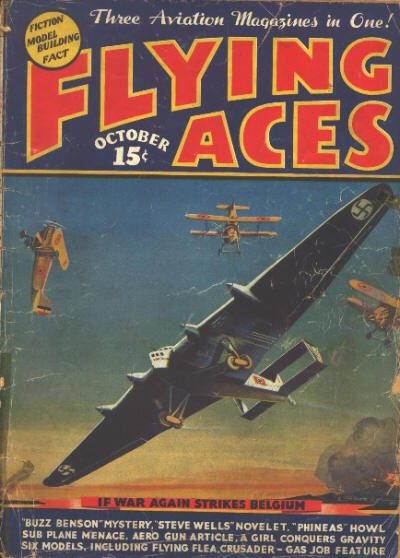 That sound can only mean one thing—it’s time to ring out the old year and ring in the new with that Bachelor of Artifice, Knight of Calamity and an alumnus of Doctor Merlin’s Camelot College for Conjurors—Phineas Pinkham.
That sound can only mean one thing—it’s time to ring out the old year and ring in the new with that Bachelor of Artifice, Knight of Calamity and an alumnus of Doctor Merlin’s Camelot College for Conjurors—Phineas Pinkham. 






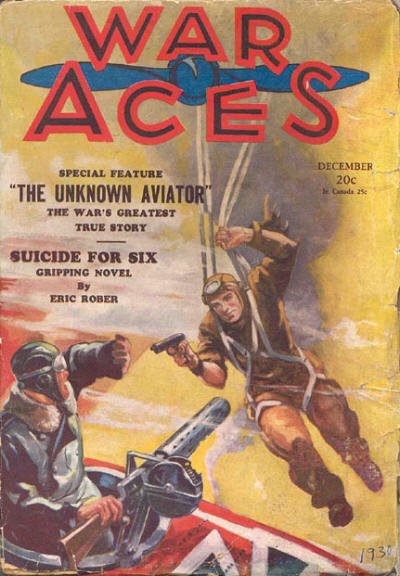 a story by Syl MacDowell! MacDowell is probably best known for his westerns. Here, MacDowell gives us a aviation yarn with a western twist—the title character is an albino Navajo who is able to see clearly in the dark! From the December 1930 issue of War Aces, it’s “Night Bird.”
a story by Syl MacDowell! MacDowell is probably best known for his westerns. Here, MacDowell gives us a aviation yarn with a western twist—the title character is an albino Navajo who is able to see clearly in the dark! From the December 1930 issue of War Aces, it’s “Night Bird.”

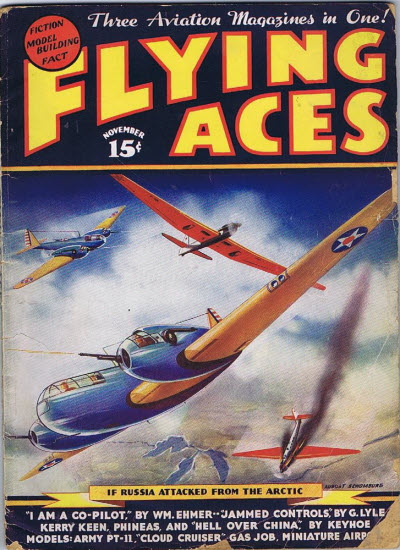 had a story in a majority of the issue of Flying Aces from his first in January 1930 until he returned to the Navy in 1942. Starting in August 1931, they were stories featuring the weird World War I stories of Philip Strange. But in November 1936, he began alternating these with sometime equally weird present day tales of espionage Ace Richard Knight—code name Agent Q. After an accident in the Great War, Knight developed the uncanny ability to see in the dark. Aided by his skirt-chasing partner Larry Doyle, Knights adventures ranged from your basic between the wars espionage to lost valley civilizations and dinosaurs. In their seventh outing from the pages of the November 1937 issue of Flying Aces, Knight and Doyle are sent to China and find themselves embroiled in a dramatic oriental sky mystery confronted by a death-ray that destroys all in it’s path! Can Agent “Q” avoid a mutated death within that eerie ray as he faces “Death Over China!”
had a story in a majority of the issue of Flying Aces from his first in January 1930 until he returned to the Navy in 1942. Starting in August 1931, they were stories featuring the weird World War I stories of Philip Strange. But in November 1936, he began alternating these with sometime equally weird present day tales of espionage Ace Richard Knight—code name Agent Q. After an accident in the Great War, Knight developed the uncanny ability to see in the dark. Aided by his skirt-chasing partner Larry Doyle, Knights adventures ranged from your basic between the wars espionage to lost valley civilizations and dinosaurs. In their seventh outing from the pages of the November 1937 issue of Flying Aces, Knight and Doyle are sent to China and find themselves embroiled in a dramatic oriental sky mystery confronted by a death-ray that destroys all in it’s path! Can Agent “Q” avoid a mutated death within that eerie ray as he faces “Death Over China!”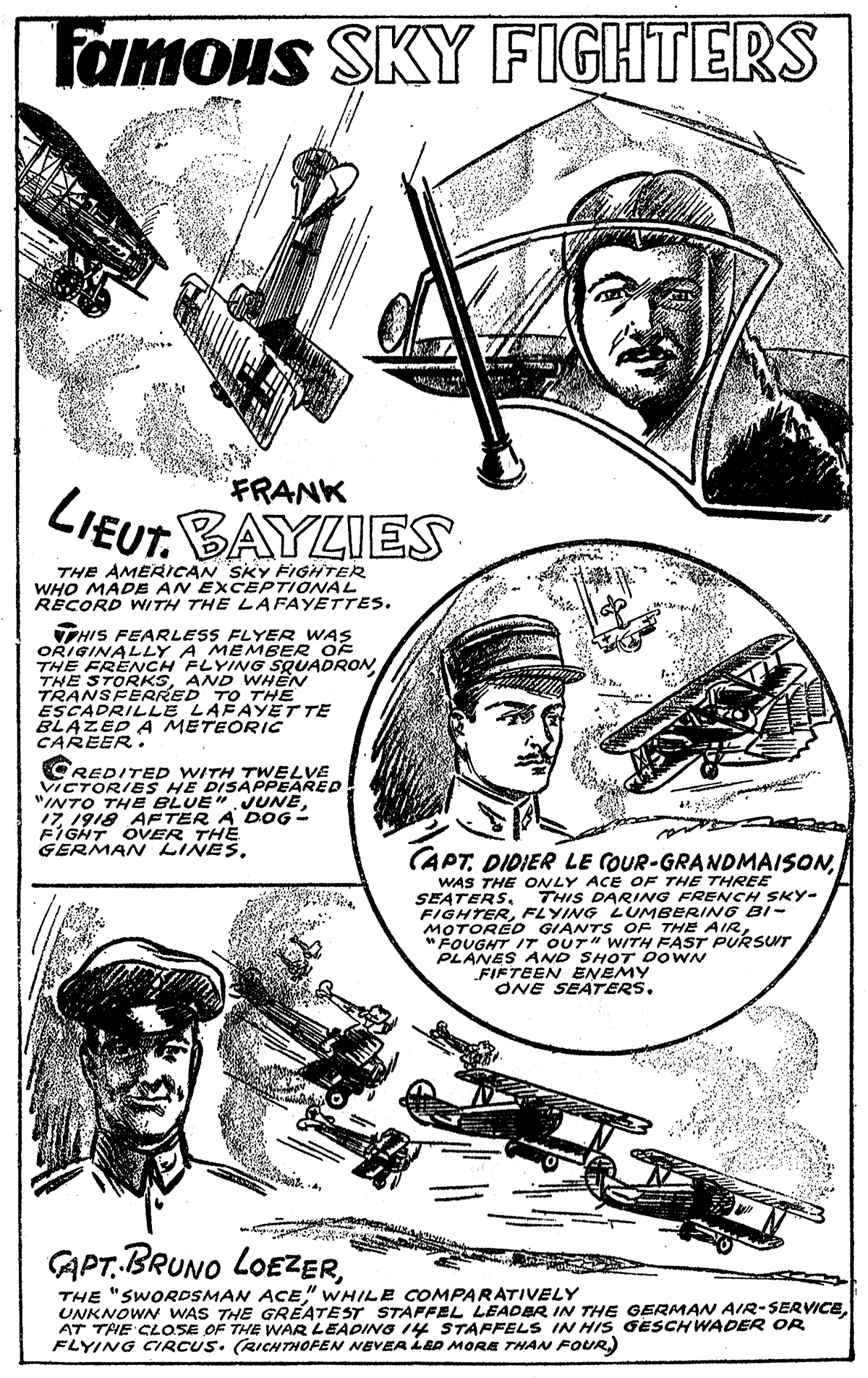
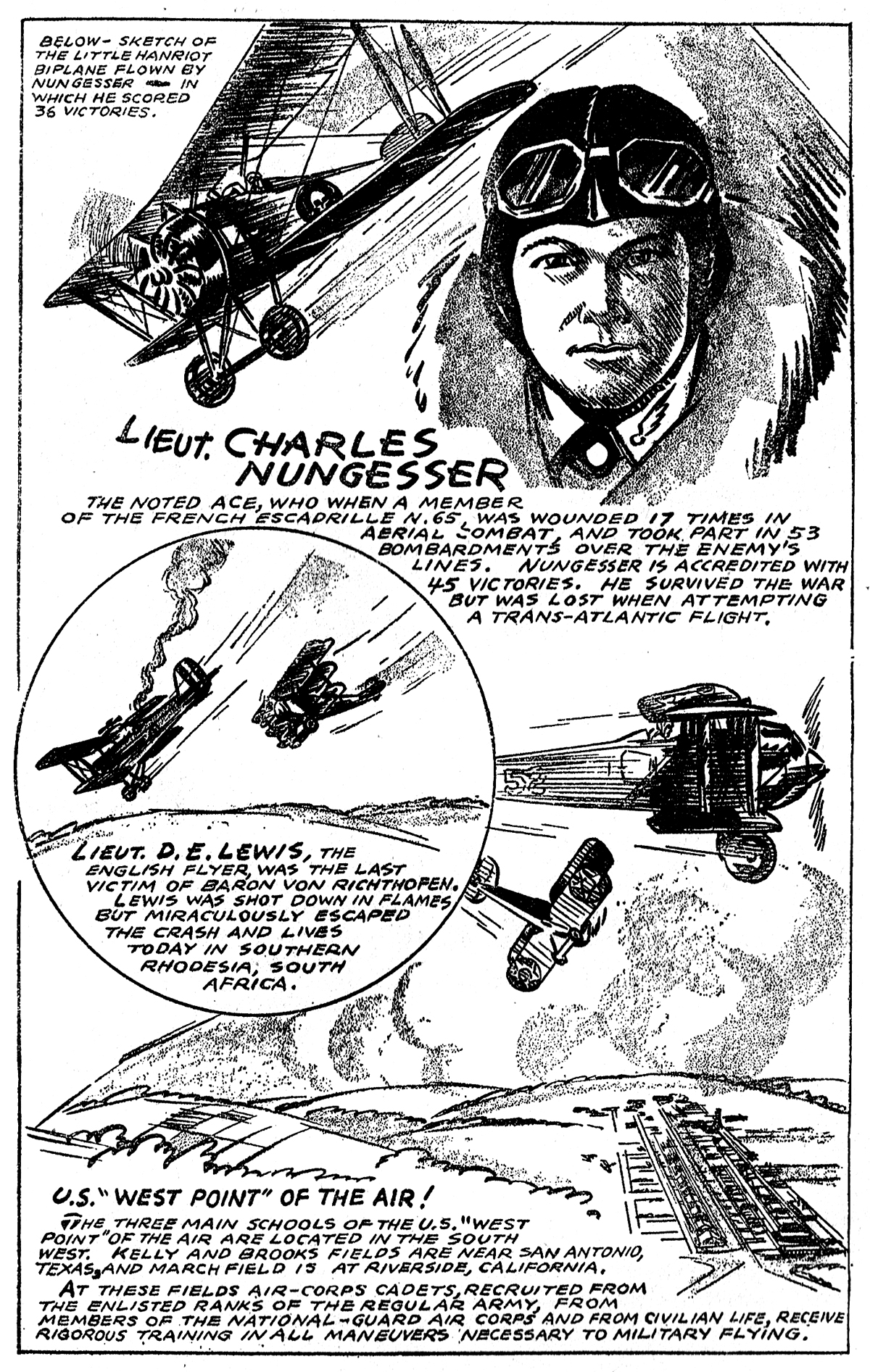
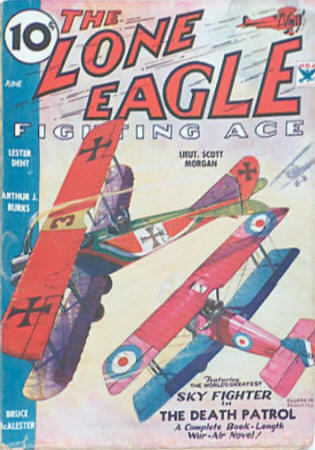 remembered as the man behind
remembered as the man behind 
